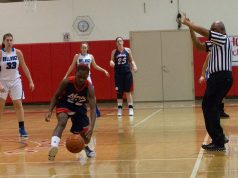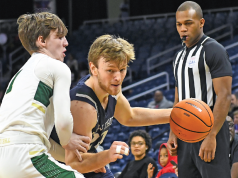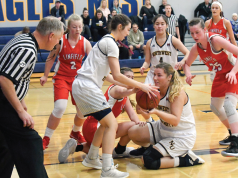There are times when a player who has control of the ball unintentionally drops it from his or her hands — a fumble — before regaining control of it. Now what?
For example, if a player ends the dribble and then fumbles the ball, he or she cannot dribble again. After recovering, he or she has the option to pass or shoot without committing a violation.
During a dribble, A1 inadvertently touches the ball simultaneously with both hands and then fumbles the ball while attempting to catch it. In that situation, A1 can retrieve the ball without violating.
Use patience in fumble situations.
When a closely guarded player ends a dribble and then the ball comes loose, it is important to know whether the loose ball was fumbled or batted by the defender. Remember, because a fumble is not a second dribble by the player, that player may pursue and recover the ball without committing a violation. However, it is illegal to dribble again after recovering the fumble. When a dribble is ended by the opponent’s bat of the ball, unlike a fumble, the dribbler can recover and then start a new dribble without violating.
Use patience in those situations. The NFHS rulebook says that a fumble is the accidental loss of player control when the ball unintentionally drops or slips from a player’s grasp. Wait until the player regains control of the ball and then passes or shoots it before determining if a violation has occurred.
There also are times when a player fumbles the ball while attempting to make a throw-in pass. Violation? Most of the time, no. For example, the official bounces the ball to A1 for a designated-spot throw-in along the endline. A1 mishandles the pass from the official and the ball rolls several feet away. A1 leaves the designated spot to retrieve the ball. Has a violation occurred? In this situation the ball inadvertently got away from A1. The administering official should repeat the throw-in process.
The administering official should blow the whistle as soon as he or she recognizes the ball was mishandled or fumbled, which will cause the ball to become dead immediately. The throw-in should then be re-administered without penalty.
*Article revised Nov. 2022 after rule language clarification*
Note: This article is archival in nature. Rules, interpretations, mechanics, philosophies and other information may or may not be correct for the current year.
This article is the copyright of ©Referee Enterprises, Inc., and may not be republished in whole or in part online, in print or in any capacity without expressed written permission from Referee. The article is made available for educational use by individuals.

















